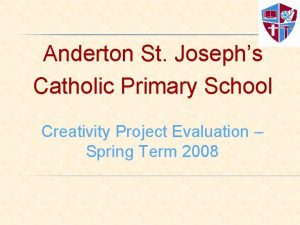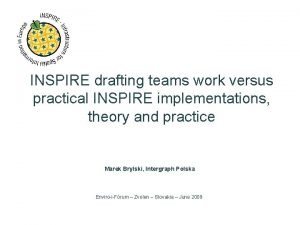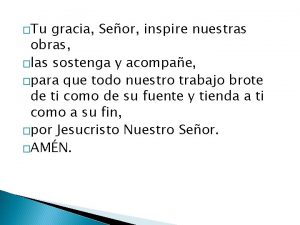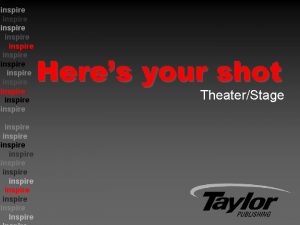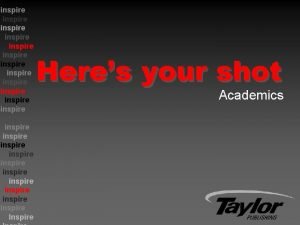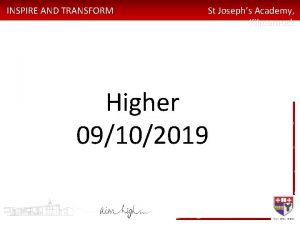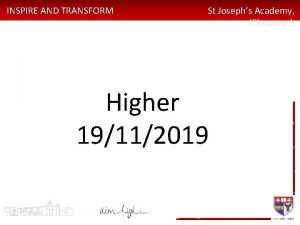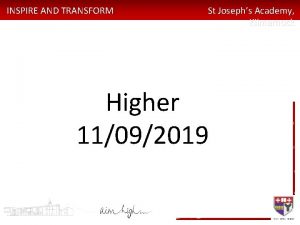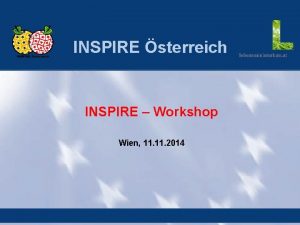INSPIRE AND TRANSFORM St Josephs Academy Kilmarnock Higher













- Slides: 13

INSPIRE AND TRANSFORM St Joseph’s Academy, Kilmarnock Higher 12/11/2019

INSPIRE AND TRANSFORM St Joseph’s Academy, Kilmarnock Today Learning Intentions: Today we will examine the importance of goals setting in our performance development process.

INSPIRE AND TRANSFORM St Joseph’s Academy, Kilmarnock Methods of Collecting Information Physical Mental 1. General Observation Schedule 1. Mental Self-Reflection Sheet 1. Focused Observation Schedule 1. Mental Toughness Questionnaire Skill: Lay up Decision making Social Emotional Team dynamics questionnaire SCAT Communication Anxiety

INSPIRE AND TRANSFORM Goal Setting St Joseph’s Academy, Kilmarnock At the beginning of our course we collected information across all four factors. However, for the purpose of our personal development plan we will only focus on two of the factors in depth. Information collected has indicated to us that our Lay Up in the Physical Factor and our Decision Making in the Mental Factor areas for development. WHAT DO WE DO WITH THIS INFORMATION? WHAT IS OUR NEXT STEP? To ensure we improve our performance we must set a Personal Development Plan (PDP). Before creating any programme, you need to know what you want to achieve. It is therefore vital that we set goals for both the short and long-term to guide our planning.

INSPIRE AND TRANSFORM Goal Setting St Joseph’s Academy, Kilmarnock We will cover Goal Setting over the next few theory and practical lessons and by the end of it you will know the following key areas: Why it is important to set goals. By the end of reading this PPT, you should be able to answer: How do I set effective goals? By the end of reading this PPT, you should be able to answer: 1) Explain why it is important to set goals before beginning a training programme. 2) Explain what a performer might consider when setting goals. Goal types. By the end of reading this PPT, you should be able to answer: 3) Describe 1 longterm and 1 short-term goal for each factor.

INSPIRE AND TRANSFORM Why is it important to set goals? St Joseph’s Academy, Kilmarnock In your jotters write down the subtitle above and then copy the mind map in to your jotter. It will give each training session a specific focus WHY? It can be used to boost motivation levels It can help a performer track and monitor their progress This means performers can fully concentrate on a specified weakness that they need to improve as it can help them select relevant approaches that complements their goal. ’ This means performer will really want to achieve the goals they have selected and will give 100% effort into every session and also ask their coach for further feedback in order to improve This means performers can assess how effective their development plan is by seeing if they have been reaching their goals

INSPIRE AND TRANSFORM St Joseph’s Academy, Kilmarnock Explain why setting goals would be helpful to a performer when planning and carrying out a development plan. (4). ‘A performer should set goals when planning their development plan as it will give each training session a specific focus. This means performers can fully concentrate on a specified weakness that they need to improve as it can help them select relevant approaches that complements their goal. ’ ‘A performer should also set goals when planning their training programme as it can be used to boost their motivation levels. This means performer will really want to achieve the goals they have selected and will give 100% effort into every session and also ask their coach for further feedback in order to improve. With such levels of desire, it can also lead to performers doing extra training outside the training ground to further bolster their weaknesses. ’ ‘Setting goals can also help a performer track and monitor their progress. This means performers can assess how effective their development plan is by seeing if they have been reaching their goals. If they find they have been reaching their goals, it can lead to them getting a confidence boost and setting even higher goals in the future to ensure they do not hit a plateau. If however they find they have not been reaching their goals, it can lead to them investigating why this has been happening and adapting their plan to make it more relevant to their performance levels. ’

INSPIRE AND TRANSFORM How do I set effective goals? St Joseph’s Academy, Kilmarnock Goals cannot be picked at random - for them to be effective they require clear thought and planning. Therefore, whenever we set goals we should follow the SMART acronym. Copy the title and mind map in to your jotter. MEASURABLE SPECIFIC SMART ADJUSTABLE TIMED REALISTIC

INSPIRE AND TRANSFORM SMART St Joseph’s Academy, Kilmarnock Q) Explain what a performer may consider when setting goals for physical factors. (4). ‘A performer may follow the SMART acronym when setting goals for physical factors. ’ ‘Their goal should be a specific one that is not written as a general statement. This means they can focus more closely on a certain element of their physical weakness and give them a clear aim to focus upon which can lead to them improving that area. ’ ‘Their goal should also be measurable and contain figures (quantitative) that can be compared against. This means it will be easier for them to measure if they have met their physical goals and can help them when considering their next goal as they simply adjust the figures based on the success of the previous session. ’ ‘Their goal should also be adjustable and not set in stone. This means they can take into account issues such as illnesses, injuries or performance plateau’s that crop up and the goal can take this into consideration and be amended to better suit the performer. ’ The performer should also ensure their goal is realistic to their ability levels. This means they can set a target that is challenging but not overstretching which can ensure that they remain motivated in their pursuit of improvement. This can then lead to them giving 100% in all sessions as they know that improvements are within their reach and they will be willing to keep persevering even when the going gets tough. ’ Finally the goals set should follow a timescale. Goals should be planned for the short term and the long term as this will provide the performer with a clear training focus and end objective. This will ensure the performer can plan training appropriately.

INSPIRE AND TRANSFORM St Joseph’s Academy, Kilmarnock Goal Types Goals can be set for either a prolonged period of time (long-term goals) or a shorter duration (short-term goals). It is important however that you apply the SMART acronym to your goals in order for them to be considered as effective.

INSPIRE AND TRANSFORM Goal Types: Specific Time bound St Joseph’s Academy, Kilmarnock Long-term goals are usually static in nature and represent an aim you wish to achieve by the end of your development plan. It is important that you apply the letters S(pecific), (R)ealistic* and T(ime-bound) to such goals. Look at the examples below. Mental: ‘By the end of my 6 week development plan, I want to improve my concentration so I can focus clearly on the man I am marking in basketball so I can stay tighter to them and intercept passes towards them. ’ Emotional: ‘By the end of my 6 week development plan, I want to control my anger when the referee makes a decision I disagree with in football so I can walk away without arguing and avoid a yellow card for dissent. ’ Social: ‘By the end of my 6 week development plan, I want to become more of a team player and support my teammates rather than criticise them when they make mistakes. ’ Physical: ‘By the end of my 6 week development plan, I want to improve my strength in rugby so I can exert a greater force than my opponents in scrums and help gain yards for my team. ’

INSPIRE AND TRANSFORM Goal Types: Specific Measurable Time bound St Joseph’s Academy, Kilmarnock Short-term goals should act as stepping stones towards achieving your overall aim and nudge you further along the pathway in pursuit of your long-term target. Short-term goals are much more dynamic in nature and owe a great deal to effective monitoring of performance and feelings. Ensure that you apply the letters (S)pecific, (M)easurable, (A)djustable*, (R)ealistic* and (T)ime bound to these goals. Take a look at the examples below. Mental: ‘By the end of today’s visualisation session, I want to clearly imagine myself staying tight to my man in 3 different defensive situations. ’ Emotional: ‘By the end of today’s deep breathing session, I want to let go of my anger at the referee within 5 deep breaths. ’ Social: ‘By the end of today’s team building games session, I want to have given my teammates at least 3 points of positive feedback and encouragement. ’ Physical: ‘By the end of today’s weights training session, I want to have squatted at least 3 reps at 90% of my 1 rep max. ’

INSPIRE AND TRANSFORM St Joseph’s Academy, Kilmarnock Your Task: 3) Describe 1 long-term and 1 short-term goal for each factor. Physical – Lay Up Mental – Decision Making When describing your answer be sure to include SMART principles in your answer.
 St joseph's academy kilmarnock
St joseph's academy kilmarnock Kilmarnock prison
Kilmarnock prison Anderton st josephs
Anderton st josephs John rasputin
John rasputin St joeys suicide
St joeys suicide Dennis josephs marburg
Dennis josephs marburg St josephs foxford
St josephs foxford Rawmarsh st josephs
Rawmarsh st josephs Difference between motivation and inspiration
Difference between motivation and inspiration Set high expectations which inspire motivate and challenge
Set high expectations which inspire motivate and challenge Inspire drafting and design
Inspire drafting and design Que tu gracia señor inspire nuestras obras
Que tu gracia señor inspire nuestras obras Gmc software ag inspire designer
Gmc software ag inspire designer How do artists inspire future generations
How do artists inspire future generations


